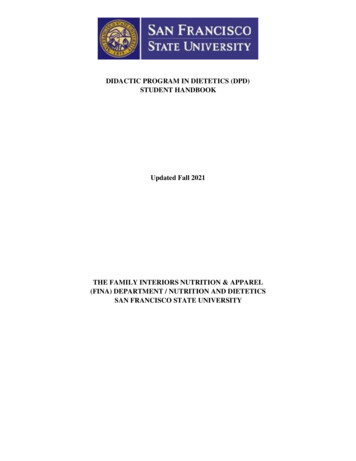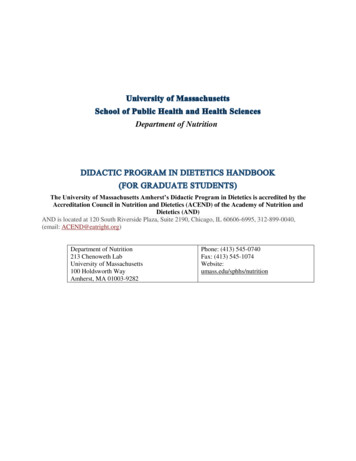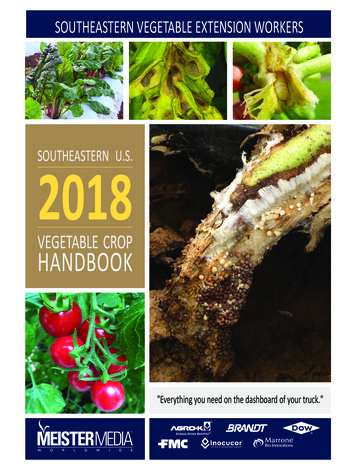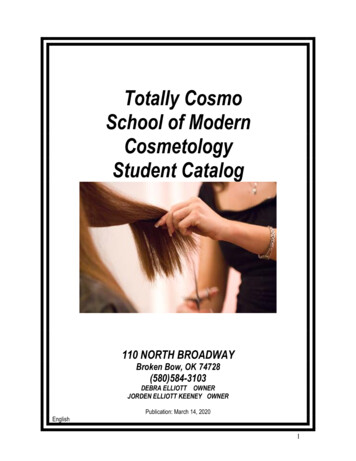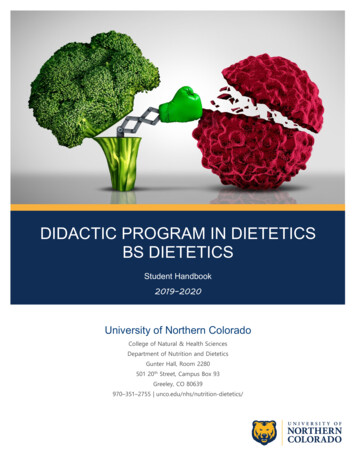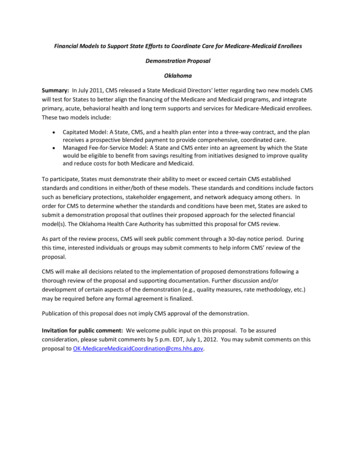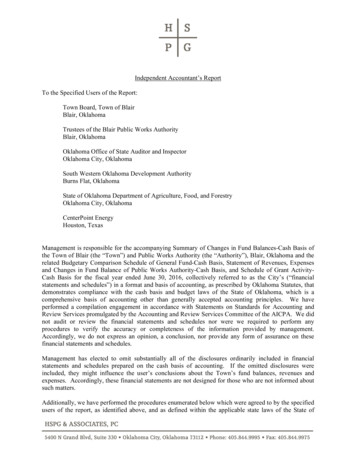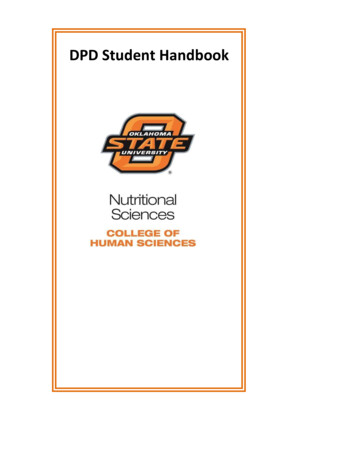
Transcription
DPD Student Handbook
Table of ContentsIntroduction & Signature PageThe Dietetics Program AT OSUWhat is Dietetics?Accreditation StatusContact InformationThe Process of Becoming a Registered DietitianApplying to Dietetic InternshipsNutrition and Dietetics Technician Registered CredentialLicensure of DietitiansWhere to go for more information about the professionOSU DPD Program Mission, Goals, ObjectivesDietetics CurriculumStudy Abroad2 2 Articulation Agreement with Tulsa Community CollegeTuition and FeesProgram CostsKnowledge RequirementsRequired Knowledge Components for DPDsTips for Dietetics StudentsAdvisersComputer InformationDietetics Community on CANVASNSCI 3440 Pre-Professional Experience – Experiential LearningNSCI 4331 Quantity Food Production Practicum – Experiential LearningScholarshipsRequesting Recommendations from Faculty MembersNSCI ClubAcademy of Nutrition and DieteticsOklahoma Academy of Nutrition and DieteticsOutstanding Dietetic Student AwardNorth Central District Dietetic AssociationNSCI Specialist at the OSU LibraryOSU and Human Sciences Career ServicesUndergraduate Research OpportunitiesOSU Service-Learning Volunteer CenterCommunicationDPD CalendarDPD PoliciesDPD Application and Admission 15151516161617171718
Assessment of Prior Learning for Undergraduate StudentsAssessment of Prior Learning for Post-Baccalaureates and InternationalStudentsFormal Assessment of Student Learning and Regular Reports of Performanceand Progress18DPD Retention and Remediation ProceduresDisciplinary/termination proceduresGraduation and/or DPD RequirementsVerification Statement ProceduresComplaints against the DPD ProgramACEND Procedure for Complaints against a ProgramNon-discrimination PolicyExperiential Learning PoliciesOSU Policies and ProceduresOSU Application and Admission RequirementsAttendance and Tardiness PoliciesWithdrawal and Refund of Tuition and FeesOSU Academic Calendar and Class SchedulesOSU Academic IntegrityDisciplinary and Termination ProceduresStudent GrievancesProtection of Privacy of Student InformationAccess to Personal FilesStudent Support ServicesAcademy Code of EthicsFAQ – Completing the DPD after completing a bachelor’s degreeForms2019-20 Transcript Evaluation List for Post-baccalaureates2018-20 DPD Professional and Sciences Courses for DICASRequest for Transcript Evaluation in order to receive a Verification 829Welcome to the Dietetics Program at OSU!The student handbook has been written in order to consolidate information that will help you navigatethe dietetics program. Students who have chosen the Dietetics option in the Department of NutritionalSciences are part of the Didactic Program in Dietetics (DPD). The DPD is an ACEND accredited program,and it provides the education that you need in order to apply for a dietetic internship.Our NSCI website is an easily accessible resource that includes specific information about being anundergraduate in the Nutritional Sciences Department/Dietetics Program.2
Becoming a registered dietitian is a journey to an interesting, diverse profession! You need to be wellprepared so that you can be successful in this journey. You’ll need to take all of your courseworkseriously. Your early courses are building blocks for the nutrition and management courses in your juniorand senior years. You need to build a strong foundation of science knowledge in order to understandhow nutrition affects human health. Your GPA is an indication of your understanding of the dieteticscurriculum, and it will be an important factor when you enter the competition for a dietetic internshipposition. When you apply for a position in a dietetic internship, you’ll need to show that you havedeveloped professional skills through work, volunteer experiences, and leadership opportunities.Our faculty and staff want you to be successful. Our courses include the knowledge and learningactivities that you need. We’ll provide information and advising to help you navigate through yourcollege years. Our students have graduated from the OSU DPD and become Registered Dietitiansthrough the OSU Dietetic Internship or one of the ACEND accredited dietetic internships across thecountry. Our alumni are also supporters of our program, and you’ll be able to meet some of themthrough our freshman level course, through job-shadowing, special presentations, and professionalmeetings.The first step to becoming informed is to read this handbook. After you’ve read through it, print and signthis page. Then turn it in to the DPD Director. Questions? Please let me know.Sincerely,Catherine Palmer, MS, RDN, LDDirector, Didactic Program in DieteticsCatherine.Palmer@okstate.eduI have read and understand the information contained in this student handbook. If I do not understandthis information, I will contact the DPD Director for clarification.Signature:Date:Printed nameThe Dietetics Program at OSUWhat is Dietetics?According to the Academy of Nutrition and Dietetics, “dietetics is the integration and application ofprinciples derived from several disciplines—including nutrition, biochemistry, physiology, food scienceand composition, management, food service, and the behavioral and social sciences—to achieve andoptimize human health. Dietetic professionals translate the scientific evidence regarding humannutrition and use that information to help shape the food intake or choices of the public.”3
Accreditation StatusThe OSU Didactic Program in Dietetics is continuously accredited by the Accreditation Council forEducation in Nutrition and Dietetics (ACEND) of the Academy of Nutrition and Dietetics (the Academy),120 South Riverside Plaza, Suite 2190, Chicago, IL 60606, (800)877-1600 x 5400.http://www.eatrightpro.org/resources/acendOur program completed the ten-year self-study and site visit process in 2011, and the ACEND Board ofDirectors voted in favor of continuous accreditation at the June 2011 meeting.The program is operating under the 2017 ACEND Accreditation Standards and will be undergoing an ACEND sitevisit for reaccreditation in early 2020.Contact InformationOSU DPD DirectorCatherine Palmer, MS, RDN, LDDepartment of Nutritional SciencesCollege of Human SciencesOklahoma State University301 Human Sciences (mailing address)313 Human Sciences (office address)Stillwater, OK 74078405-744-7469 rogram-osu.htmlNSCI Main Office301 sciThe Process of Becoming a Registered Dietitian Nutritionist (RDN)There are three steps to becoming an RD or RDN:1)The OSU Didactic Program in Dietetics (DPD) is the first step in the three step process ofbecoming a Registered Dietitian Nutritionist (RDN) (same as Registered Dietitian or RD). Thedidactic (or instructional) step requires graduation with a bachelor’s degree and completionof the dietetics curriculum from an ACEND*-accredited program such as the OSU DPD.2)The second step is the successful completion of an ACEND-accredited Dietetic Internship.3)The third step is passing the national registration exam administered by the Commission onDietetic Registration of the Academy of Nutrition and Dietetics.After registration RDNs are required to complete 75 clock hours of continuing professional educationover five year periods in order to maintain registration.4
* Accreditation Council for Education in Nutrition and Dietetics of the Academy of Nutrition and Dietetics, 120 South Riverside Plaza, Suite2190, Chicago, IL 60606, (800)877-1600 x 5400. http://www.eatrightacend.org/ACEND/Applying to Dietetic InternshipsQualified seniors in their last semester and graduates of the DPD program may apply to ACENDaccredited Dietetic Internships and participate in the computer matching process which is administeredby D&D Digital (www.dnddigital.com) in the spring or fall. Application is a very competitive process, andthere are 250 internships across the United States and Puerto Rico. Most programs are using theDietetic Internship Centralized Application Process (DICAS) https://portal.dicas.org/. Upon completion ofa bachelor’s degree and the required DPD courses, the graduate will receive the DPD verificationstatement from the DPD Director. This statement is required for entrance into a dietetic internship.Dietetic Internships include 1200 hours of supervised practice. Many internships include graduate schoolhours or require completion of a master’s degree. After January 1, 2024, a master's degree in any fieldwill be required along with the dietetic internship in order to qualify to take the RD exam.Graduates of the OSU DPD who wish to apply to the OSU Dietetic Internship may use the pre-selectprocess or the DICAS and D&D Digital computer matching process (spring match). The ACEND website isan excellent source of additional information on the DI application process and computer matchinghttp://www.eatrightacend.org/ACEND/. The OSU DI webpage is the best source of information on thepreselect process.The OSU Dietetic Internship is a combined Master’s Degree/DI program. Interns are required tocomplete the M.S. degree and the supervised practice in order to receive a DI verification statementneeded in order to take the RDN exam. ents/dietetic-internship.htmlThere is currently a significant shortage of dietetic internship positions across the country. A studentshould strive to work towards a strong GPA and obtaining work, volunteer, and leadership experience inorder to be competitive. Information on the internship shortage can be found on the Academy ofNutrition and Dietetics website rition and Dietetic Technician Registered Credential (NDTR)Nutrition and Dietetic Technician Registered Credential (NDTR) - Graduates of DPD programs may takethe registration exam administered by CDR to earn the Nutrition and Dietetic Technician Registered(NDTR) (also known as Dietetic Technician Registered or DTR) credential without completing the 450hours of supervised practice required of graduates of two-year ACEND-accredited NDTR programs(Pathway III).OSU DPD graduates must contact the OSU DPD Director in order to start the NDTR registration examprocess which may be started after the DPD Verification Statement has been earned. NDTRs work under5
the supervision of Registered Dietitian Nutritionists in a wide variety of settings including hospitals andlong term care. dpd-pathway-iiiLicensure of DietitiansMost states have licensure laws for registered dietitians. The public is able to identify credible nutritionprofessionals through credentials. In Oklahoma, licensure is title protection. It is unlawful for personswho are not registered dietitians to call themselves registered dietitians and for persons who are notlicensed to use the credential “LD”. A person who successfully completes a dietetic internship may applyto become a provisional licensed dietitian with supervision by a licensed dietitian. Upon passing the RDNexam, that person may become a licensed dietitian and use the “LD” credential after his or her name.Registration and licensure are intended to protect the public and to assure them of the professionalpreparation of Registered Dietitian Nutritionists.The website of the Oklahoma State Board of Medical Licensure and Supervisionis www.okmedicalboard.org. The Academy of Nutrition and Dietetics maintains a list of state licensure informationon its website at ty-health- ure-agency-contact-listWhere to Go for More Information About the ProfessionThe Academy of Nutrition and Dietetics provides information of interest to dietetics students includinglists of ACEND accredited programs, information about becoming a registered dietitian and licensure ontheir website at www.eatrightpro.org. The Academy is the world’s largest organization of food andnutrition professionals. The Commission on Dietetic Registration website is www.cdrnet.org. Thewebsite of the Oklahoma Academy of Nutrition and Dietetics is www.oknutrition.org. The Bureau ofLabor Statistics provides information about careers in the Occupational Outlook Handbook.OSU DPD Mission, Goals, and ObjectivesThe Department of Nutritional Sciences advances health and quality of life of individuals andcommunities and prepares professionals through discovery, education, and application of scientificknowledge.The mission of the OSU Didactic Program in Dietetics is to promote human health and quality of life bypreparing students for supervised practice leading to eligibility for the CDR credentialing exam to becomea RDN.Goal 1 – The program will prepare graduates capable of succeeding in dietetics or a postgraduate field whichutilizes their dietetics education.6
Objective 1.1: At least 80% of program students complete program/degree requirements within three years.(150% of the program length). Objective 1.2: 60% of program graduates apply for admission to a supervised practice program prior to orwithin 12 months of graduation. Objective 1.3: 60% of program graduates are admitted into a supervised practice program within 12 months ofgraduation. Objective 1.4: At last 90% of DI Directors from programs accepting our graduates who respond to a survey willrate program graduate’s preparation for supervised practice as “Satisfactory” or better. Objective 1.5: At least 90% of Graduate Coordinators/Advisors from programs accepting our graduates whorespond to a survey will rate them as “Satisfactory” or better in their overall readiness to succeed as an internor graduate student, respectively.Goal 2 – The DPD will prepare graduates to competently promote human health and quality of life throughevidence-based practice. Objective 2.1: The programs’ one year pass rate (graduates who pass the registration exam within one year offirst attempt on the CDR credentialing exam for dietitian nutritionists is at least 80%. Objective 2.2: On the biennial OSU Undergraduate Alumni Survey, at least 85% of dietetics graduates whorespond to the survey will rate themselves as “adequately” or “very well” prepared “to develop evidencebased nutrition messages for the public”.Program outcomes data are available upon request.Dietetics CurriculumStudents who wish to pursue the registered dietitian nutritionist (RDN) credential will major inNutritional Sciences (NSCI) and select the Dietetics option. Nutritional Sciences is part of the College ofHuman Sciences. The other options in the department do NOT meet the curricular requirements forbecoming an RDN. At this time the requirements for admission to the program are the same asrequirements for admission to NSCI.Our courses are primarily provided on the Stillwater campus. See the section on the 2 2 transferagreement with Tulsa Community College for information on completing the first two years at TCDegree sheets for Dietetics are found in the OSU Catalog of Degree Requirements found . Students are assigned to the degree sheet for theirmajor and option that is current when they enter OSU after high school, the year of matriculation. Thedegree sheet includes information about minimum GPA requirements and lists all of the courses which astudent must take. “The responsibility for satisfying all requirements for a degree rests with the student.7
Advisors, faculty members and administrators offer help to the student in meeting this responsibility.” (OSUCatalog, University Academic Requirements, Section 7.1 Graduation Requirements)Finish in Four Plans of Study show the sequencing of courses in order to complete the program in 4years. The Plan of Study shows prerequisites and takes into consideration those courses which areoffered fall only or spring only. The Plans of Study by degree year are found uate-students/finish-in-four.html.Current course descriptions are found in the OSU Catalog on the OSU Registrar’s talog and on the Banner website.The Dietetics curriculum is planned so that courses and learning experiences build on each other. It isimportant to maintain the planned sequence so that prerequisites are met. Advisors will help studentskeep on track, but each student should keep track of their own degree requirements and learn to usethe resources in Banner at http://my.okstate.edu, in http://star.okstate.edu, and on the registrar’swebsite, https://registrar.okstate.edu/ .Students may add minors to the dietetics curriculum. Special care is needed to maintain the sequence ofthe dietetics courses, and it can add to the length of time to graduation. However, if a student knowsthat they are particularly interested in a specific aspect of dietetics, then a minor could be useful. Minorsare included in the OSU Degree Requirements. https://registrar.okstate.edu/Minors-and- Certificates .Study AbroadStudy Abroad must be carefully planned if a student wants to spend a semester abroad. The plan needsto be discussed with the DPD Director and the advisor to make sure that as many hours as possible willcount for the DPD curriculum. Study abroad experiences are great opportunities to increase culturalcompetence. OSU has a Study Abroad office to assist students in making arrangements and in identifyingappropriate coursework. Summer international experiences are not likely to affect progress towardgraduation. https://abroad.okstate.edu/2 2 Transfer Agreement with Tulsa Community CollegeThe Nutritional Sciences Department has a transfer agreement with Tulsa Community College (TCC) forthe Dietetics option. These agreements outline the courses that will be taken at TCC for an Associate’sDegree and then transferred to OSU for credit and applied to the DPD curricula. The agreement isposted along with degree sheets and fact sheets on the NSCI rgraduate-students/degree-sheets.htmlTuition and FeesThe number of hours required to graduate are found on the Dietetics degree sheet. OSU uses a blocktuition system. It is important for students and parents to understand the new tuition policy so thatstudents can optimize the number of hours covered by their tuition dollars when planning enrollment8
each semester. Students taking 12-14 hours/semester, especially in the last two semesters beforegraduation, should also investigate block rate exceptions and the appeals process athttp://blockrate.okstate.edu/appeals.OSU provides a tuition and fees calculator on the Office of the Bursar website. A 15-hour (12-18 hours ofblock tuition) semester’s tuition is estimated at 4,509 for in-state students and 12,269.25 for out-ofstate students.Information on fees per credit hour can be found online at the Office of the Bursar.Books and supplies are estimated at 1260/year.Online courses are charged an additional per hour fee which varies by college. The College of HumanSciences charge is 100/credit hour as of 3/30/2020. Banner course information includes informationabout online fees. A substantial portion of this fee supports student resources in the college.Residential Life housing rates are posted on their website at http://www.reslife.okstate.edu/. Universityhousing and meals information is available here: https://reslife.okstate.edu/housing/rates .The Financial Aid Office provides details about Tuition, Fees, and Cost Estimates athttp://bursar.okstate.edu/tuition-and-fees. The Office of the Bursar collects tuition, fees, campushousing, and other university expenses and disburses financial aid and scholarshipshttp://bursar.okstate.edu. Scholarship and financial aid information is found athttps://financialaid.okstate.edu/ .Program CostsDPD specific fees include expenses associated with required courses (approximate prices):NSCI 3440 (1hr) NSCI Preprofessional Experience and NSCI 4331 Quantity Food Production Practicum:Students may need two TB tests (about 15 each), a background check ( 28), drug tests for entranceinto healthcare facilities during pre-professional experience ( 35), flu shot (estimated at 25), and/orprofessional liability insurance ( 15). This is dependent on the student's choice of facilities. Healthcarefacilities also require proof of immunizations (MMR, Hep A& B, Varicella immunization or titer, Flu Shot,Tdap). Depending on the rotation experience, students may be required to pay 36.50 forMyClinicalExchange.NSCI 4850 Food Preparation and Safety: Non-skid Shoes (varies).NSCI 3543 Food and the Human Environment: Food for food presentation- varies, depending on themenu and class size.9
Incidental costs involved with other class projects vary.Optional costs: NSCI Club Dues (optional) - 10 Academy of Nutrition and Dietetics Student Membership (optional, but required for access tothe Evidence Analysis Library on the Academy website and for the reduced price of theAcademy’s Nutrition Care Manual and eNutrition Care Process and Terminology Manual) - 60Costs involved in applying to dietetic internships: D&D Digital Computer Matching Fee - 55 DICAS (DI Centralized Application System) - 45 for first application, 20 each additionalapplication Application fees to dietetic internships and graduate programs vary-see individual websites.Knowledge Requirements for DPDsThe OSU DPD operates under the 2017 Accreditation Council for Education in Nutrition and Dietetics(ACEND) Accreditation Standards.The program’s curriculum must prepare students with the following core knowledge:Domain 1. Scientific and Evidence Base of Practice: Integration of scientific information andtranslation of research into practice.KnowledgeUpon completion of the program, graduates are able to: KRDN 1.1 Demonstrate how to locate, interpret, evaluate and use professional literature tomake ethical, evidence-based practice decisions. KRDN 1.2 Use current information technologies to locate and apply evidence-based guidelinesand protocols. KRDN 1.3 Apply critical thinking skills.2. Domain 2. Professional Practice Expectations: Beliefs, values, attitudes and behaviors for theprofessional dietitian nutritionist level of practice.KnowledgeUpon completion of the program, graduates are able to: KRDN 2.1 Demonstrate effective and professional oral and written communication anddocumentation. KRDN 2.2 Describe the governance of nutrition and dietetics practice, such as the Scope ofNutrition and Dietetics Practice and the Code of Ethics for the Profession of Nutrition andDietetics; and describe interprofessional relationships in various practice settings. KRDN 2.3 Assess the impact of a public policy position on nutrition and dietetics practice. KRDN 2.4 Discuss the impact of health care policy and different health care delivery systems onfood and nutrition services.10
KRDN 2.5 Identify and describe the work of interprofessional teams and the roles of others withwhom the registered dietitian nutritionist collaborates in the delivery of food and nutritionservices.KRDN 2.6 Demonstrate an understanding of cultural competence/sensitivity.KRDN 2.7 Demonstrate identification with the nutrition and dietetics profession throughactivities such as participation in professional organizations and defending a position on issuesimpacting the nutrition and dietetics profession.KRDN 2.8 Demonstrate an understanding of the importance and expectations of a professionalin mentoring and precepting others.3. Domain 3. Clinical and Customer Services: Development and delivery of information, products andservices to individuals, groups and populations.KnowledgeUpon completion of the program, graduates are able to: KRDN 3.1 Use the Nutrition Care Process to make decisions, identify nutrition-related problemsand determine and evaluate nutrition interventions. KRDN 3.2 Develop an educational session or program/educational strategy for a targetpopulation. KRDN 3.3 Demonstrate counseling and education methods to facilitate behavior change andenhance wellness for diverse individuals and groups. KRDN 3.4 Explain the processes involved in delivering quality food and nutrition services. KRDN 3.5 Describe basic concepts of nutritional genomics4. Domain 4. Practice Management and Use of Resources: Strategic application of principles ofmanagement and systems in the provision of services to individuals and organizations.KnowledgeUpon completion of the program, graduates are able to: KRDN 4.1 Apply management theories to the development of programs or services. KRDN 4.2 Evaluate a budget and interpret financial data. KRDN 4.3 Describe the regulation system related to billing and coding, what services arereimbursable by third party payers, and how reimbursement may be obtained. KRDN 4.4 Apply the principles of human resource management to different situations. KRDN 4.5 Describe safety principles related to food, personnel and consumers. KRDN 4.6 Analyze data for assessment and evaluate data to be used in decision-making forcontinuous quality improvement.Required Knowledge Components for DPDsThe program’s curriculum must be designed to ensure the breadth and depth of requisite knowledge needed forentry to supervised practice to become a registered dietitian nutritionist.The curriculum also includes these components:1. Research methodology, interpretation of research literature and integration of researchprinciples into evidence-based practice11
2. Communication skills sufficient for entry into professional practice3. Principles and techniques of effective education, counseling and behavior change theories andtechniques4. Governance of nutrition and dietetics practice, such as the Scope of Nutrition and DieteticsPractice and the Code of Ethics for the Profession of Nutrition and Dietetics; andinterprofessional relationships in various practice settings5. Principles of medical nutrition therapy and the Nutrition Care Process6. Role of environment, food, nutrition and lifestyle choices in health promotion and diseaseprevention7. Management theories and business principles required to deliver programs and services8. Continuous quality management of food and nutrition services9. Fundamentals of public policy, including the legislative and regulatory basis of nutrition anddietetics practice10. Health care delivery systems (such as accountable care organizations, managed care, medicalhomes)11. Coding and billing of nutrition and dietetics services to obtain reimbursement for services frompublic or private payers, fee-for-service and value-based payment systems12. Food science and food systems, environmental sustainability, techniques of food preparationand development and modification and evaluation of recipes, menus and food productsacceptable to diverse populations13. Organic chemistry, biochemistry, anatomy, physiology, genetics, microbiology, pharmacology,statistics, logic, nutrient metabolism, integrative and functional nutrition and nutrition acrossthe lifespan14. Cultural competence and human diversity; human behavior, psychology, sociology oranthropology12
Tips for Dietetics StudentsAdvisersAll College of Human Sciences students are advised by an adviser in the Center for Student Success, 101HSCI. After advising is completed each semester, juniors and seniors must also meet with the DPDdirector before their advising hold is released. Students should become familiar with using the STARsystem at http://star.okstate.edu. This may be used to schedule appointments with advisers and toaccess advising documents. All dietetics students (or students who are interested in the degree) arewelcome to visit with the DPD Director. To make an appointment, the student may e-mailCatherine.Palmer@okstate.edu or call 405-744-7469 and should include information about possibletimes to meet that work with the student’s schedule.Computer InformationOnline courses and computer resources for on-campus courses are delivered through Canvas:canvas.okstate.eduStudents may download free software including Microsoft Office from http://it.okstate.edu/ .Computer labs are found in 037 HSCI for student use. Printers are available without charge to -students/computer-labs-technology.htmlDietetics Community on CanvasThe DPD Director maintains the STW NSCI-Didactic Program in Dietetics Community in Canvas. Thecommunity is a site where announcements, resources for current students, and links to helpful sites areposted. Resources to help you apply for dietetic internships are posted in the community. To selfregister in the community, go to: https://canvas.okstate.edu/enroll/ANCLLK.NSCI 3440 Preprofessional Experience – Experiential LearningDietetics students are required to take one hour of NSCI 3440. Students will job-shadow, work, orvolunteer for 40 hours anywhere in the world in the field of food, nutrition, and/or healthcare andcomplete documentation including a paper to earn one hour of credit. Many students take this coursebetween the junior and senior years. The course is online so that students do not have to be in Stillwaterto complete requirements and is offered spring, summer, and fall. The instructor has set up a CanvasCommunity, “NSCI 3440 Community”, to provide guidance well in advance of the experience.Students may self-enroll in the Canvas Community: https://canvas.okstate.edu/enroll/G6JNFMFor this course, students are required to identify appropriate professionals to shadow or work/volunteerexperiences which will strengthen dietetics education and provide insights into the professional arena.
Study Abroad 8 2 2 Articulation Agreement with Tulsa Community College 8 Tuition and Fees 9 Program Costs 9 . Catherine.Palmer@okstate.edu . Our program completed the ten-year self-study and site visit process in 2011, and the ACEND Board of

